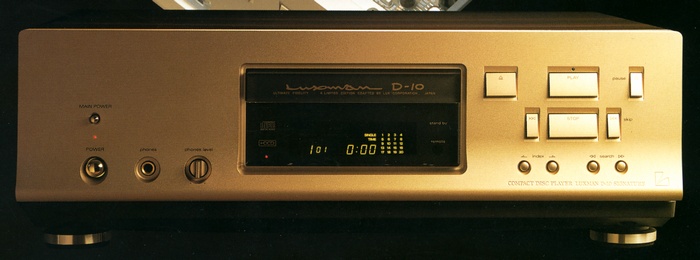
LUXMAN D-10
¥ 550,000 (Released in November 1997)
Commentary
HDCD-compatible CD player developed with technologies such as Tower DAC.
The D/A converter uses the sine magnitude method to solve the 0 cross distortion, which was the biggest drawback of a multi-bit DAC.
The structure of the D/A conversion section adopts 4-stage stack tower DAC method.
In general, various characteristics such as distortion factor and SN ratio can be improved by driving multiple DACs in parallel. The Tower DACs were developed to take full advantage of the advantages of parallel use. The current balance is maintained in the vicinity of the strictly selected DACs, the boards with the shortest high-frequency bus are stacked on top of each other, and the number of stacks is determined to be four by precise data analysis.
This tower DAC structure has the advantage of minimizing the data / clock lines to individual DACs, improving jitter and signal-to-noise ratio by using a shield case, and reducing the influence of mutual interference and straight capacitor by inserting a high-speed buffer into the data line to the tower DAC.
The D-10 has a built-in HDCD decoder can play high-quality HDCD discs.
HDCD is a CD-compatible disc with the equivalent of 20 bits of information and employs a mapping and dither addition algorithm based on auditory psychological experiments.
In addition, the technology that interpolates the lowest bit using a dither signal with energy distribution frequency characteristics that do not give a sense of incongruity to the music signal at the time of 8 times oversampling interpolation provides natural realism even during normal CD playback.
High-inertia power supply is used for the power supply part.
This power supply circuit employs a newly developed large-capacity custom capacitor with low loss and excellent rapid charge / discharge characteristics. This circuit is able to cope with sudden current changes in DAC where discrete pulse signals and continuous analog signals exist.
In addition, a sufficiently large power transformer is adopted, the winding is divided into four systems according to the application, and the interference through the power supply between circuits is suppressed by current interference prevention technology such as STAR circuit.
The analog low-pass filter uses a high-purity design passive low-pass filter.
The filter with sharp roll-off characteristics is composed of an air-core coil with a shield case developed as a custom part and a copper foil styrene condenser, enabling natural reproduction sound while minimizing group delay characteristics in the audible band.
The analog outputs of the SSC circuit make use of Lux's amplifier technology, enabling high slew rate and wide bandwidth. The gain of this SSC circuit is the most suitable amplifier for a high-output CD-player, realizing a high Tyner mix range and high linearity.
The power supply section, including the power transformer and rectifier diode, has a box structure, and the power supply circuit is divided into digital and analog circuits to avoid interference from the power supply of each signal system.
In order to prevent interference between digital and analog circuits, the D-10 incorporates an RF amplifier for amplifying the small signal of the laser pickup, digital signal processing for EFM demodulation and error correction, etc. in the drive mechanism. The output is passed through a shield box and input to the nearest digital filter. In addition, a control microcomputer for controlling the entire process is placed right next to the digital filter to store the digital circuit in a very small area.
The disc tray is made of high-density FRP resin and has a tray locking mechanism during play to eliminate the adverse effect of resonance. The central mechanism section is also covered to prevent contamination of the laser pickup output signal due to light leakage.
The base chassis uses FRP base chassis containing glass fibers with rigidity and moderate internal loss.
Custom parts developed in-house are used everywhere to further improve the sound quality.
The digital outputs include coaxial digital output using a large toroidal pulse transformer, AES/EBU balanced digital output and AT&T/ST link.
The analog output has a balanced output in addition to the RCA pin terminal.
System remote control is included.
This remote control not only controls the CD player, but also controls the basic functions of the Luxman control amplifier and pre-main amplifier via the bus line.
Model Rating
| Type | CD Player |
| Number of quantization bits | 16-bit linear quantization |
| Sampling frequency | 44.1kHz |
| Number of channels | 2 channels (stereo) |
| Frequency characteristic | 20 Hz to 20 kHz ± 0.5 dB |
| Dynamic range | 98dB(EIAJ) |
| Signal-to-noise ratio | 103dB(EIAJ) |
| Channel separation | 103dB(EIAJ) |
| Total harmonic distortion factor | 0.003% (1 kHz, EIAJ) |
| Output level | Balance/Unbalance:2V |
| Digital output system | Digital audio interface |
| Digital output level | Coaxial:0.5Vp-p AES/EBU:5Vp-p |
| Pickup system | Semiconductor laser pickup |
| Number of storable tracks | 24 songs |
| Pwer | 100 VAC, 50Hz/60Hz |
| Power consumption | 29W |
| Maximum external dimensions | Width 467x Height 161x Depth 425 mm |
| Weight | 16.5kg |
| Attachment | Wireless Remote Control |
.jpg)
.jpg)
.jpg)
.jpg)
.jpg)
.jpg)
.jpg)
.jpg)
.jpg)
.jpg)